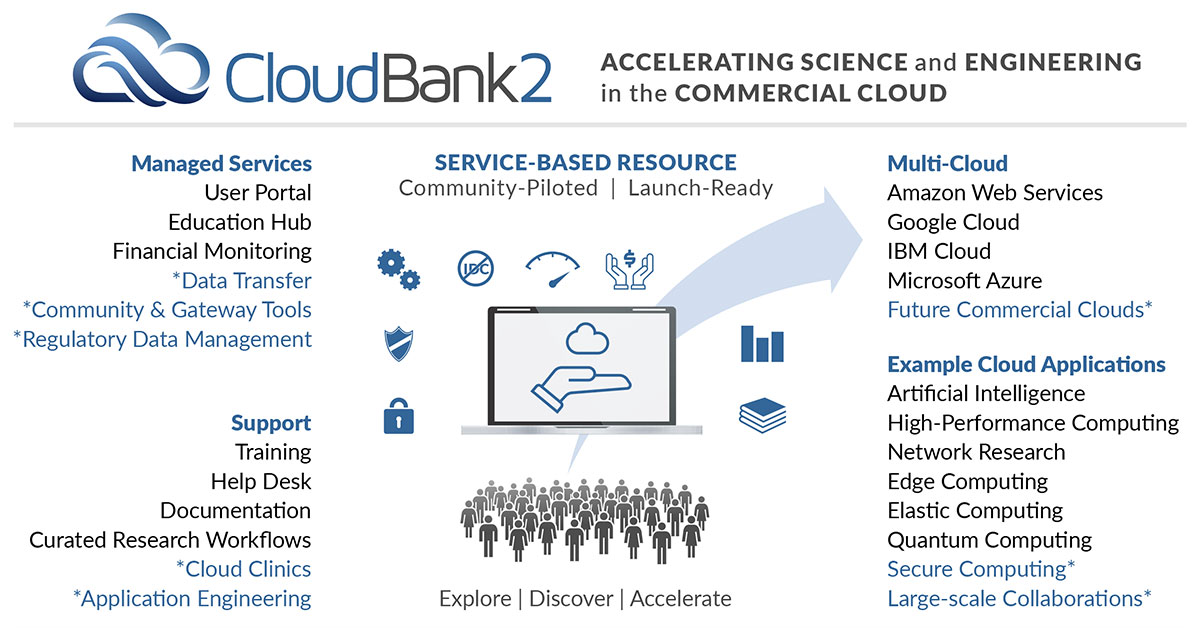UC San Diego Leads $20M Grant to Provide Commercial Cloud Resources to National Research Community
Story by:
Published Date
Article Content
The University of California San Diego will lead a $20 million grant from the U.S. National Science Foundation (NSF) for the acquisition and deployment of commercial cloud resources to support approximately 500 research projects annually across the nation over the next five years.
CloudBank 2: Accelerating Science and Engineering Research in the Commercial Cloud (CloudBank 2) is a joint project among the San Diego Supercomputer Center—part of the School of Computing, Information and Data Sciences—and the Information Technology Services Division at UC San Diego; the University of Washington’s (UW) eScience Institute; and the UC Berkeley College of Computing, Data Science, and Society. CloudBank 2 will be a service-based resource, providing commercial cloud resources, from Jupyter Notebooks and secure data to the latest GPUs and quantum computers. These resources will support a variety of science and engineering use cases beyond the capabilities of any single physical location.
“We will build upon our NSF-funded CloudBank pilot project, a flexible multi-cloud infrastructure now in its sixth year of operation, and scale to the broader science and engineering community,” explained CloudBank 2 Principal Investigator (PI) Shava Smallen, also the lead developer of the CloudBank Portal. Joining Smallen on the CloudBank 2 project as co-PIs are: UC San Diego’s Vince Kellen and Michael Norman, who serves as PI for the CloudBank pilot; UW’s Sarah Stone and UC Berkeley’s Katherine Yelick.
For national academic researchers, CloudBank 2 will integrate multi-cloud capabilities into the ACCESS ecosystem—a program established and funded by the NSF to help researchers and educators with or without supporting grants to use the nation’s advanced computing systems and services.
“Researchers will access commercial cloud resources free of charge via the ACCESS allocation process beginning in December, just as they do any other NSF-funded computational resource,” Smallen said. “Our experience during the six years of the CloudBank pilot demonstrates a clear need for commercial cloud resources, as well as deeper engagement and assistance. CloudBank 2’s services and team will help researchers unfamiliar with cloud computing to adopt new services and optimize workflows. The goal is to enable scientists and educators to quickly overcome obstacles and focus on their research, thanks to NSF support.”
The initial commercial clouds that will be part of CloudBank 2 include Amazon Web Services, Google Compute Platform, Microsoft Azure and IBM Cloud, all of which are currently available through CloudBank. These clouds offer a rich set of resilient production cyberinfrastructure resources, platforms and services that support the full range of computation, data analysis and AI research across all of S&E. In addition to diverse Infrastructure as a Service (IAAS) offerings for compute, storage and networking, commercial clouds have led the way in deploying elastic, scalable, on-demand platforms for big data management and analytics, machine learning, internet-of-things applications and quantum computing. Advantages of the commercial cloud include ubiquitous availability, zero capital cost, vast bursting capability, continuous hardware and software refresh, scalability, reliability, composability and growing marketplace services such as NVIDIA DGX Cloud. Commercial clouds have been identified as an essential element in the federal government’s strategic plan for creating and sustaining a federated advanced computing ecosystem and will complement the NSF portfolio by diversifying and expanding the resources available to the research community.
“Commercial clouds play an important role in meeting the capacity and capability demands of surging AI R&D across multiple disciplines, widening access and provisioning scalable environments for AI education and training in the classroom for the future workforce,” said Norman, former SDSC director and one of the 12 Task Force members of the National Artificial Intelligence Research Resource (NAIRR) Implementation Plan.
CloudBank 2 will build upon and enhance CloudBank’s three core research and education services: a CloudBank Portal that makes it easy for researchers to access and manage their cloud accounts, share access with collaborators and monitor their spending; Financial Operations that pay monthly cloud vendor bills and remove the burden on users to manage financial accounts or use their own credit cards and an Education Hub based on an open-source stack for teaching on the commercial cloud, which has facilitated interactive computing for students and educators by offering an easy on-ramp for data science education.
“CloudBank 2 will expand our Education Hub to
Other CloudBank 2 features include: 1) leveraging Sherlock services at SDSC to support projects that require access to regulated data, 2) providing portal tools to support communities and 3) integrating new commercial cloud vendors to offer innovative new capabilities and additional cost savings to the science and engineering community. The latter activity will be overseen by co-PI Vince Kellen, the chief information officer for UC San Diego, who will lead CloudBank 2’s financial operations.
Over a five year period, CloudBank 2 will be able to observe how the S&E community requests, ingests and uses different cloud technologies. By analyzing this data, CloudBank can tailor its support and training materials to better meet the needs of the research community and focus outreach activities to broaden its reach. Moreover, this data can be shared with the NSF and the broader community to help guide future research and technology investments.
Both CloudBank and CloudBank 2 are supported by the NSF (award nos. 1925001 and 2505560, respectively).
Learn more about research and education at UC San Diego in: Artificial Intelligence

Overview of CloudBank 2 and its project elements, with blue asterisks indicating proposed new features beyond those of the CloudBank pilot. Image courtesy of SDSC.
Share This:
You May Also Like
Stay in the Know
Keep up with all the latest from UC San Diego. Subscribe to the newsletter today.




